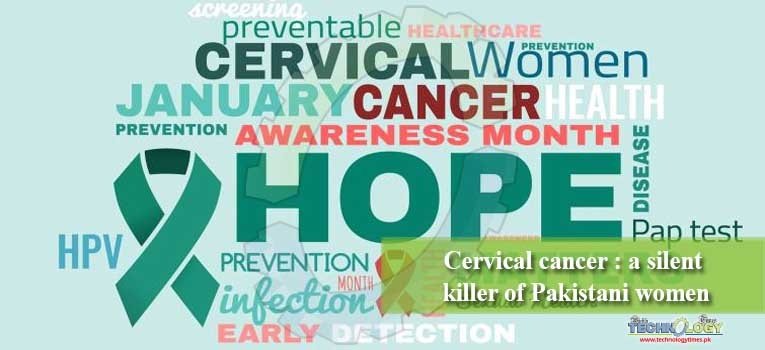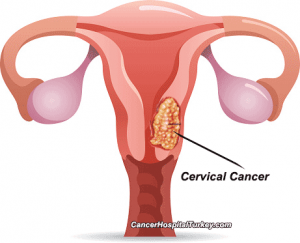“Pakistan ranked 7th in the cervical cancer deaths. cervical cancer, being the second most common cancer in women, is the leading cause of cancerous deaths in women and every woman is at risk.’’
 Unfortunately, every day 20 women die of cervical cancer which can be prevented 100% through vaccination.
Unfortunately, every day 20 women die of cervical cancer which can be prevented 100% through vaccination.
Cervical Cancer : An introduction
Cervical cancer forms in the cervix ,the lower narrow part of the uterus. The uterus, a hollow, pear-shaped organ, is located in a woman’s lower abdomen, between the bladder and the rectum. The cervix forms a canal that opens into the vagina, which leads to the outside of the body.
Cervical cancer occurs when normal cells in the cervix change into cancer cells. This normally takes several years to happen, but it can also happen in a very short period of time. Squamous intraepithelial lesion (SIL) is a general term for the abnormal growth of squamous cells on the surface of the cervix.They are the real cause of cervical cancer.

General causes of cervical cancer:
- Human papillomavirus (HPV) infection
- Having many sexual partners
- Smoking
- Birth control pills (oral contraceptives) used over the long term
- Engaging in early sexual contact
Signs and symptoms of cervical cancer:
- Abnormal vaginal bleeding
- Increased vaginal discharge
- Bleeding after going through menopause
- Pain during sex
- Pelvic pain
Crisis in Pakistan
Pakistan has an increasing trend of cervical cancer cases. They are normally diagnosed at advanced stages when a woman is in the prime of her life, taking care of her children and family.
It is very important to educate masses and persuade them to get their daughters vaccinated. The exact rate of incidence and prevalence of cervical cancer is not known in Pakistan because it is an ignored disease in terms of screening and prevention.
Increasing Risk
In 2002, the prevalence of cervical cancer in Pakistani women was 0.009% (9/100,000) while in 2008 it was 0.019% (19.5/100,000), according to advance research started by the World Health Organisation (WHO). The country is moving from low-risk levels to moderate-risk levels making it a danger zone where young girls are more at risk than before.
Lack of awareness
Lack of awareness is the major cause behind the high fatality rate of the disease. Policymakers must come together to raise awareness among the public about the disease to encourage women to get screened and vaccinated against this deadly but preventable disease. Our population is unaware due to social and cultural barriers. Awareness is direly needed among the parents about the disease to protect their daughters.
Culturally, we spend money on dowry and weddings of our daughters but, when it comes to their health, we are ignorant and consider such topics a taboo. Vaccination against this deadly disease would be the best gift parents should give their daughters on their wedding, as more than 60 per cent women, who contracted this disease, die.
‘’ The best time to get vaccinated is when girls reach the age of puberty. All girls above nine can benefit from the vaccine”
Genetic Relevance
There is no known genetic cause of cervical cancer. However, it may run in some families. Women with a mother or sister who had the disease have a higher risk of developing it themselves.
It is currently not understood if this familial tendency is caused by an inherited condition that makes some women more vulnerable to HPV infection than others. Alternatively, the increased incidence in some families may be related to the likelihood that family members may share one or more of the other non-genetic risk factors.
Prevention is better than cure
The treatment is very painful and costly, but prevention is easy and accessible. Vaccination along with screening can reduce the incidence of cervical cancer by 94%.The screening should be continued even after vaccination.
Screening details
All women between the ages of 21 and 65 receive screening by Pap smear every three years. Women aged 30-65 may opt to have a combination of Pap smear and HPV testing every 5 years. Women who have had a total hysterectomy for a benign condition no longer have a cervix, and thus do not need to be screened for cervical cancer.
However, women who have had a subtotal hysterectomy still have a cervix and should be screened. Certain conditions and special situations may change the frequency of screening, such as a history of abnormal Pap smears.
Need of hour
Pakistan bears the burden of 7,311 women fatalities due to cervical cancer every year and ranks seventh out of 50 such countries. It’s high time we all should unite against cervical cancer to protect our girls and women from this silent killer. It is essential for every woman to have regular screening for cervical cancer.
Pap smear tests and other techniques need to be made readily available in the country. The vaccination should at least be available at basic health units or rural health centers. The government should take adequate measures in this context and other healthcare organizations should contribute too in this cause to spread awareness.